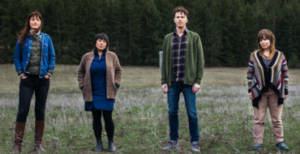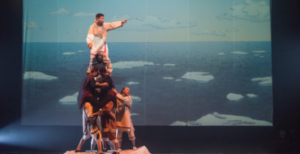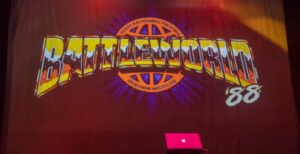Upon arrival at 1405 Anderson Street, fourteen participants, including myself, were greeted and presented with the following information:
 I had the unique opportunity to take part in an audio excursion known as The Voyage presented by Boca Del Lupo as part of a Micro Performance Series. It was executed in complete darkness on board a real shipping container, which was on an old loading ramp in Granville Island.
We were politely asked to turn our cellphones off and it was then explained, with great consideration, that if anyone felt claustrophobic and needed to be evacuated, that there would be a team-member on the inside to get us safely out.
“Wow!” I thought. How lovely it would have been for the real people in transport to have that option (or to even have cellphones for that matter).
The point of this exercise was to feel and experience, in 15 minutes, just a taste of what it would be like for refugees, sex trade workers and the like to undertake the long and arduous journey across vast expanses of ocean. These people would have to hang on tenaciously to their dreams of freedom and keep with them their hopes for a new and better life. And this ‘better life’ would need to sustain them through the nightmare transit that would get them to their final destinations.
I was pretty psyched to embark on this journey and prepared myself accordingly. This intense and imaginative journey, as began to become very apparent to me, would prove to require a great amount of concentration and total suspension of disbelief.
We were crammed tightly into a blacked-out panel van (it was difficult to think of anything good coming out of such a creepy situation). I was correct in my assumption because when the van stopped, we were herded into a bleak and dingy shipping container smelling of slight rot and chemicals with a prevalent metallic odor that permeated my skull. Then the doors slammed shut.
I kept my eyes open wide in the pitch-black. I started seeing spots and other blotchy configurations that gave me a false sense of sight. We all sat quietly and listened, ever so fixedly, ears keenly attuned to the sonic onslaught. It lasted 10 minutes and then the doors opened. No one said a word.
We clapped uncomfortably, expecting something to be said perhaps, but nothing was so we then turned around and made off on our own ways, a bit dazed and a little confused.
Now. I have purposely not given anything away about the actual sounds heard on the excursion, as it is such a singular and short-lived experience. I will say this.
However, some more information at the beginning would have really helped set the tone for the journey. For example, how many people are on the average container, how long do these trips usually take, what and how much do they have to eat, is there enough air, how many people survive, how many die and how many of them actually get to live out their dreams in our beautiful country?
At the end of the voyage, I believe it could have been better if the audience was provided with a list of websites or something to encourage us to get the word out. If in some way, we were enabled to do our parts by giving us some guidance. Who to write to or how we can help stop the need for these desperate measures. All and all, I’m glad to have participated in The Voyage. It truly succeeded in being a thought provoking and interesting endeavor.
For more information: http://www.bocadellupo.com/
I had the unique opportunity to take part in an audio excursion known as The Voyage presented by Boca Del Lupo as part of a Micro Performance Series. It was executed in complete darkness on board a real shipping container, which was on an old loading ramp in Granville Island.
We were politely asked to turn our cellphones off and it was then explained, with great consideration, that if anyone felt claustrophobic and needed to be evacuated, that there would be a team-member on the inside to get us safely out.
“Wow!” I thought. How lovely it would have been for the real people in transport to have that option (or to even have cellphones for that matter).
The point of this exercise was to feel and experience, in 15 minutes, just a taste of what it would be like for refugees, sex trade workers and the like to undertake the long and arduous journey across vast expanses of ocean. These people would have to hang on tenaciously to their dreams of freedom and keep with them their hopes for a new and better life. And this ‘better life’ would need to sustain them through the nightmare transit that would get them to their final destinations.
I was pretty psyched to embark on this journey and prepared myself accordingly. This intense and imaginative journey, as began to become very apparent to me, would prove to require a great amount of concentration and total suspension of disbelief.
We were crammed tightly into a blacked-out panel van (it was difficult to think of anything good coming out of such a creepy situation). I was correct in my assumption because when the van stopped, we were herded into a bleak and dingy shipping container smelling of slight rot and chemicals with a prevalent metallic odor that permeated my skull. Then the doors slammed shut.
I kept my eyes open wide in the pitch-black. I started seeing spots and other blotchy configurations that gave me a false sense of sight. We all sat quietly and listened, ever so fixedly, ears keenly attuned to the sonic onslaught. It lasted 10 minutes and then the doors opened. No one said a word.
We clapped uncomfortably, expecting something to be said perhaps, but nothing was so we then turned around and made off on our own ways, a bit dazed and a little confused.
Now. I have purposely not given anything away about the actual sounds heard on the excursion, as it is such a singular and short-lived experience. I will say this.
However, some more information at the beginning would have really helped set the tone for the journey. For example, how many people are on the average container, how long do these trips usually take, what and how much do they have to eat, is there enough air, how many people survive, how many die and how many of them actually get to live out their dreams in our beautiful country?
At the end of the voyage, I believe it could have been better if the audience was provided with a list of websites or something to encourage us to get the word out. If in some way, we were enabled to do our parts by giving us some guidance. Who to write to or how we can help stop the need for these desperate measures. All and all, I’m glad to have participated in The Voyage. It truly succeeded in being a thought provoking and interesting endeavor.
For more information: http://www.bocadellupo.com/
715,195 laden shipping containers arrived in the Port of Vancouver in 2011 including 2,877,676 metric tonnes of household goods, 1,160,636 metric tonnes of construction & materials, 355 930,610 metric tonnes of industrial, auto and vehicle parts and 1,548,748 metric tonnes of ‘others’. Included in ‘Others’ are some of the six hundred individuals that the RCMP estimates are smuggled into the country each year.
 I had the unique opportunity to take part in an audio excursion known as The Voyage presented by Boca Del Lupo as part of a Micro Performance Series. It was executed in complete darkness on board a real shipping container, which was on an old loading ramp in Granville Island.
We were politely asked to turn our cellphones off and it was then explained, with great consideration, that if anyone felt claustrophobic and needed to be evacuated, that there would be a team-member on the inside to get us safely out.
“Wow!” I thought. How lovely it would have been for the real people in transport to have that option (or to even have cellphones for that matter).
The point of this exercise was to feel and experience, in 15 minutes, just a taste of what it would be like for refugees, sex trade workers and the like to undertake the long and arduous journey across vast expanses of ocean. These people would have to hang on tenaciously to their dreams of freedom and keep with them their hopes for a new and better life. And this ‘better life’ would need to sustain them through the nightmare transit that would get them to their final destinations.
I was pretty psyched to embark on this journey and prepared myself accordingly. This intense and imaginative journey, as began to become very apparent to me, would prove to require a great amount of concentration and total suspension of disbelief.
We were crammed tightly into a blacked-out panel van (it was difficult to think of anything good coming out of such a creepy situation). I was correct in my assumption because when the van stopped, we were herded into a bleak and dingy shipping container smelling of slight rot and chemicals with a prevalent metallic odor that permeated my skull. Then the doors slammed shut.
I kept my eyes open wide in the pitch-black. I started seeing spots and other blotchy configurations that gave me a false sense of sight. We all sat quietly and listened, ever so fixedly, ears keenly attuned to the sonic onslaught. It lasted 10 minutes and then the doors opened. No one said a word.
We clapped uncomfortably, expecting something to be said perhaps, but nothing was so we then turned around and made off on our own ways, a bit dazed and a little confused.
Now. I have purposely not given anything away about the actual sounds heard on the excursion, as it is such a singular and short-lived experience. I will say this.
However, some more information at the beginning would have really helped set the tone for the journey. For example, how many people are on the average container, how long do these trips usually take, what and how much do they have to eat, is there enough air, how many people survive, how many die and how many of them actually get to live out their dreams in our beautiful country?
At the end of the voyage, I believe it could have been better if the audience was provided with a list of websites or something to encourage us to get the word out. If in some way, we were enabled to do our parts by giving us some guidance. Who to write to or how we can help stop the need for these desperate measures. All and all, I’m glad to have participated in The Voyage. It truly succeeded in being a thought provoking and interesting endeavor.
For more information: http://www.bocadellupo.com/
I had the unique opportunity to take part in an audio excursion known as The Voyage presented by Boca Del Lupo as part of a Micro Performance Series. It was executed in complete darkness on board a real shipping container, which was on an old loading ramp in Granville Island.
We were politely asked to turn our cellphones off and it was then explained, with great consideration, that if anyone felt claustrophobic and needed to be evacuated, that there would be a team-member on the inside to get us safely out.
“Wow!” I thought. How lovely it would have been for the real people in transport to have that option (or to even have cellphones for that matter).
The point of this exercise was to feel and experience, in 15 minutes, just a taste of what it would be like for refugees, sex trade workers and the like to undertake the long and arduous journey across vast expanses of ocean. These people would have to hang on tenaciously to their dreams of freedom and keep with them their hopes for a new and better life. And this ‘better life’ would need to sustain them through the nightmare transit that would get them to their final destinations.
I was pretty psyched to embark on this journey and prepared myself accordingly. This intense and imaginative journey, as began to become very apparent to me, would prove to require a great amount of concentration and total suspension of disbelief.
We were crammed tightly into a blacked-out panel van (it was difficult to think of anything good coming out of such a creepy situation). I was correct in my assumption because when the van stopped, we were herded into a bleak and dingy shipping container smelling of slight rot and chemicals with a prevalent metallic odor that permeated my skull. Then the doors slammed shut.
I kept my eyes open wide in the pitch-black. I started seeing spots and other blotchy configurations that gave me a false sense of sight. We all sat quietly and listened, ever so fixedly, ears keenly attuned to the sonic onslaught. It lasted 10 minutes and then the doors opened. No one said a word.
We clapped uncomfortably, expecting something to be said perhaps, but nothing was so we then turned around and made off on our own ways, a bit dazed and a little confused.
Now. I have purposely not given anything away about the actual sounds heard on the excursion, as it is such a singular and short-lived experience. I will say this.
However, some more information at the beginning would have really helped set the tone for the journey. For example, how many people are on the average container, how long do these trips usually take, what and how much do they have to eat, is there enough air, how many people survive, how many die and how many of them actually get to live out their dreams in our beautiful country?
At the end of the voyage, I believe it could have been better if the audience was provided with a list of websites or something to encourage us to get the word out. If in some way, we were enabled to do our parts by giving us some guidance. Who to write to or how we can help stop the need for these desperate measures. All and all, I’m glad to have participated in The Voyage. It truly succeeded in being a thought provoking and interesting endeavor.
For more information: http://www.bocadellupo.com/ 








